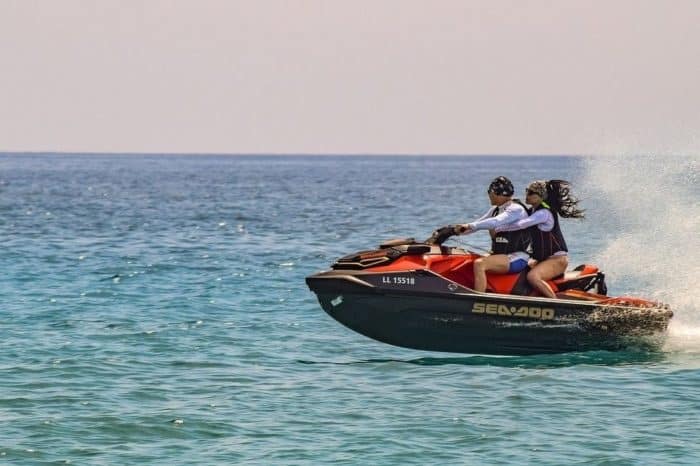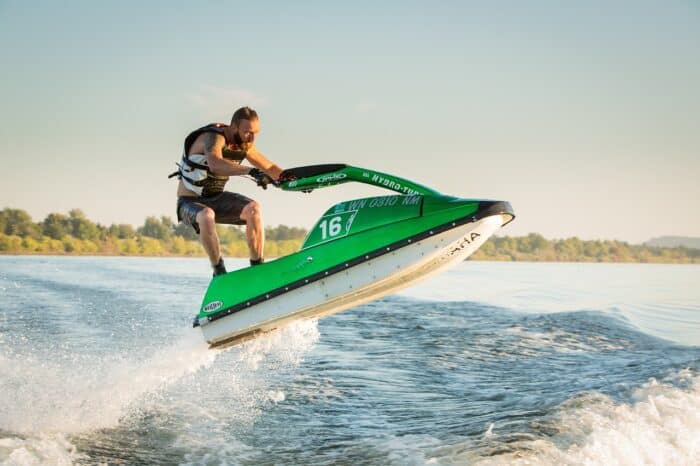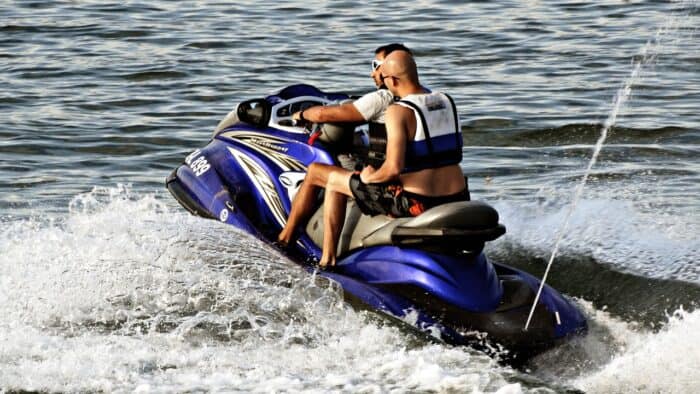PWC Fire Extinguishers: What You Need to Know
What’s the last thing you expect to experience when you head out on the water in a jet ski? Fire. Boating and fire have a long and dangerous history. Fires do not occur often on personal watercraft, but they do happen. As temperatures get hotter, the potential becomes higher. Operating on hot days, engines can overheat and vent into inboard engine compartments. Those vapors only need a spark to explode. And in such a small space you have very limited time to react. If you’re too far out in the water, a fire could prove deadly in a matter of moments.
All a fire needs to exist is heat, fuel and oxygen. A personal watercraft can supply this in more ways than one. The engine runs on gasoline. It creates heat as it operates. Oxygen, of course, is in ready supply. Not only does the gasoline in a PWC offer the opportunity for fires, so does the electrical system. PWC should come with a mounting bracket for a fire extinguisher.
In order to keep yourself safe on the water, you need to be prepared for any eventuality. That includes fire.
What Do Fire Extinguisher Ratings Mean?
Understanding what fire extinguisher is best for a PWC means understanding ratings. Fire extinguishers are rated with letters and numbers. Each has a very specific meaning.
A: A fire extinguisher with an A rating is designed for wood and paper fires, as well as general trash fires. Textiles and plastic fires can also be fought with a Class A extinguisher. These uses chemicals like monoammonium phosphate to smother fires.
B: A Class B extinguisher is meant to fight flammable liquid fires. That means fires fueled by oil, gasoline, kerosene, cooking oil, and paint. A Class B extinguisher is the kind of thing you want to battle fires on most boats. That includes PWC.
C: Class C extinguishers are used to manage fires in energized electrical equipment. These types of extinguishers use chemicals to smother the flames. They have to be non-conductive to prevent the risk of electrical shock. They may also be designed to cause as little damage as possible to wires and electrical systems.
Each fire extinguisher is also rated with a number. So you may see something like 1-A or 10-B. The number refers to the size of the fire the extinguisher can manage. The greater the number, the bigger the fire. For instance, a 1-A extinguisher can put out a fire on an 8 x 8 wood panel. A 10-A extinguisher can put out a fire on a 17 x 17 panel.
Ratings for PWC Fire Extinguishers
Any ship needs a fire extinguisher on board. You want one approved by the US Coast Guard. Not all personal watercraft fire extinguishers are created equally however. Not every fire extinguisher is useful against every fire. When you’re in such a confined space as a PWC, you don’t want to struggle with the wrong fire extinguisher.
Extinguishers are rated according to the Underwriters Laboratory rating system. This is abbreviated as UL rating.
The best choice here is a UL rated 5 B:C fire extinguisher. B means it can handle flammable liquids and gases. That’s things like the oil or gasoline in your personal watercraft fuel system. C means it can also be used in electrical systems, such as in and around the battery.
The Danger of Electrical Fires
Electrical fires are often overlooked when it comes to personal watercraft. The big and most present danger to most people is a fire in the fuel system. There are a number of ways a fire could start on a PWC. Environmental conditions like an especially hot summer can help contribute. But what else needs to be addressed?
Improper maintenance of a PWC is arguably the biggest problem. A PWC engine doesn’t vent the same way as a normal boat. PWC engines do not have blowers. A blower is basically just a fan that keeps air moving. Because of their size, things like jet skis don’t use these. Instead, they have passive venting. Passive venting allows fumes to escape as the PWC is in motion and air flows through. They work well enough when the machine is actually in motion. That said, when you have it sitting still, air flow is stifled. That can allow fumes to build up. On a very hot day, that can become dangerous. It’s always a good idea to open the engine compartment to let any fumes escape before operation.
In terms of electrical fires, you need to check the engine while it ventilates. Wires that have become frayed, corroded, or dirty need to be addressed. Debris has a way of worming into your electrical system. Sometimes even small animals can get in there and chew wires. If not maintained, these can short out. That can lead to a life-threatening electrical fire. They can happen quickly. That means you won’t have time to call the coast guard or anyone else for help. If that’s the case, you’ll want to make sure you have the right kind of personal watercraft fire extinguisher.
Using Your Personal Watercraft Fire Extinguisher
It seems like having a personal watercraft fire extinguisher should be enough. However, you need to also understand it. That may sound silly but if you have never used a fire extinguisher before, and many people haven’t, do you know what to do? Do you aim the nozzle at the base of the flame or the fire itself? Should you fire it in one long stream or in short bursts? Do you need to move it back and forth or keep it still?
The best thing you can do is familiarize yourself with the instructions. There is a clear instruction label on the side of your extinguisher. Some have a metal pull pin or other security features. These are to prevent accidental discharge. You’ll need to know how to disengage those. Check pressure status as well. All the steps required will be listed. If it’s too old, replace it.
Usually a fire on a PWC should be attacked from the base. Release the metal pull pin. Press the button or pull the trigger with the nozzle pointed at the source of the flames. Move the extinguisher back and forth to cover the area evenly. Do this until the flames are fully extinguished. Always defer to the instructions on your particular extinguisher, however.
What If I Can’t Reach The Fire or Extinguisher?
This is a problem with some PWC fires. You may actually be sitting over where the fire starts. If that’s the case, you have some options.
A fire needs heat, fuel, and oxygen. Deprive it of any of those, and the fire dies. If you can’t get to the fire or the fire extinguisher, flipping the PWC may work. If you submerge the engine compartment you will at least be cutting off oxygen. Be cautious, however. Fuel and oil can leak into the water around you. Since they are lighter than water, the fire could continue to burn on the water’s surface.
If things are out of hand, save yourself before the PWC. Swim away and seek help rather than risk your personal safety.
Categories: Personal Watercraft












